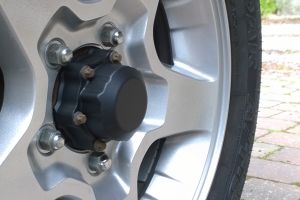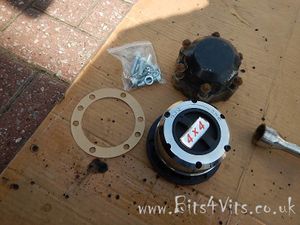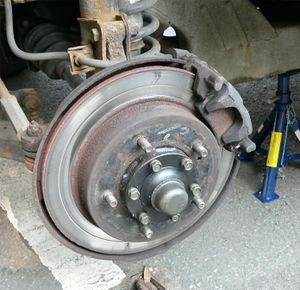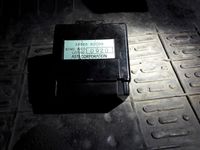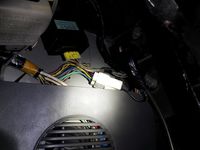Difference between revisions of "Manual or fixed front wheel hub heads"
(Solution about blocking the vacuum system significantly expanded) |
m (Small corrections) |
||
| Line 32: | Line 32: | ||
| − | [[File:Vacuum and manual wheel hub head - A01.jpg|thumb|left|Vacuum and manual free wheeling wheel hub head for a comparison]] | + | [[File:Vacuum and manual wheel hub head - A01.jpg|thumb|left|Vacuum (top) and manual (bottom) free wheeling wheel hub head for a comparison]] |
* Most Jimnys (especially those which are regularly used in all-terrain duty) will, inevitably, have problems with the vacuum system for front wheel hub heads. | * Most Jimnys (especially those which are regularly used in all-terrain duty) will, inevitably, have problems with the vacuum system for front wheel hub heads. | ||
Revision as of 14:41, 11 September 2017
![]() The content of any article might be expanded / improved in the future - revisit it sometimes.
The content of any article might be expanded / improved in the future - revisit it sometimes.
![]() Seen a mistake? Know something that isn't written? Edit and change this article yourself!
Seen a mistake? Know something that isn't written? Edit and change this article yourself!
![]() Some images in the article (if present) can be enlarged by clicking on them.
Some images in the article (if present) can be enlarged by clicking on them.
Contents
- 1 Introduction
- 2 Solution with manually operated hub heads
- 3 Solution with fixed wheel hub heads
- 4 Converting from vacuum to manually operated front wheel hub heads
Introduction
- Jimnys have pneumatically (vacuum) operated free-wheeling front wheel hub heads / caps.
- Pneumatic system is very convenient when it works, but it can be a nightmare when it fails.
- The purpose of this article is to provide you an alternative solution to repairing that system - replacing it altogether with manually operated free-wheeling front wheel hub heads.
![]() The wiki article "Vacuum hubs - Checking and testing" contains the following:
The wiki article "Vacuum hubs - Checking and testing" contains the following:
- The general introduction about the purpose and operation of free-wheeling wheel hub heads;
- Description of operating systems for free-wheeling wheel hub heads;
- All the details about vacuum operated free-wheeling wheel hub heads;
- Related issues and repair solutions.
![]() Wheel hub heads / caps are usually just shortened in naming to "hubs", but a "hub" is actually an entire wheel hub assembly - the casing which contains the wheel bearing with its seals, the steering knuckle surround casing, the king pin bearings and (in the case of the Jimny) the pipes and passages which transport the air / vacuum through the wheel hub assembly to/from wheel hub heads.
Wheel hub heads / caps are usually just shortened in naming to "hubs", but a "hub" is actually an entire wheel hub assembly - the casing which contains the wheel bearing with its seals, the steering knuckle surround casing, the king pin bearings and (in the case of the Jimny) the pipes and passages which transport the air / vacuum through the wheel hub assembly to/from wheel hub heads.
Solution with manually operated hub heads
Reasons and advantages
- Most Jimnys (especially those which are regularly used in all-terrain duty) will, inevitably, have problems with the vacuum system for front wheel hub heads.
- Diagnosis and repair, depending on the issue, can range from a quick detection and a simple/cheap fix, to a thorough and arduous investigation with expensive repairs.
- However, there is luckily an alternative solution - to completely discard the vacuum system and vacuum front wheel hub heads, and install manually operated free wheeling front wheel hub heads (like in Samurais and other classic 4WD vehicles) or even fixed hub heads.
- This will eliminate the entire vacuum system, and with it all the risks and issues which it imposes.
- Manually operated free wheel wheel hub heads generally have the lowest risk of failures, as there is by far the least amount of components which can fail.
- The modification is relatively simple to perform, with required parts widely available on the second hand market and/or in the aftermarket.
This solution is worth considering in the following scenarios:
- If you are tired with chasing faults in your vacuum system for front wheel hub heads;
- If the determined repair of the fault is too expensive;
- If you just want to preventively minimize the risk of a failure;
Disadvantages
- The operator has to exit the vehicle and manually switch both hub heads whenever their (dis)engagement is desired.
- As most manual free wheeling hub heads have no anti-tamper mechanisms, a malicious person can easily (dis)engage a hub head while the vehicle is parked (easily remedied by the driver when detected, but can cause confusion while driving in the meantime).
- If water enters into a manual free wheeling hub head, it can freeze the manual (un)locking spring mechanism in the hub head during frigid weather. If this happens while the hub head is disengaged, it can prevent the vehicle from using 4WD transmission when it is needed the most.
Practical tips when using manual wheel hub heads
- It is NOT strictly required to engage/disengage the wheel hub heads every time when switching between 2WD<->4WD transmission modes.
- In other words, it is completely fine to leave the wheel hub heads engaged during 2WD transmission mode. The vehicle will just use a bit more fuel (since more metal is spinning) and that metal will naturally wear more compared to when being disconnected and resting idle.
- This means that you can have the hub heads engaged all the time during the day(s) when you expect to shift between 2WD<->4WD transmission modes often. This will save you many exists from the vehicle.
- If you suspect upcoming freezing weather conditions (for example for the next morning after parking the car in the evening), it might be a good precautionary measure to leave the hub heads engaged over night on the parking lot, in case that the (un)locking mechanism in them freezes. Better to have them frozen ON than frozen OFF!
- Develop a habit to occasionally check the (dis)engagement status of your manual hub heads, in case that someone has fiddled with them on a parking lot!
Solution with fixed wheel hub heads
- It is also possible to install fixed hub heads.
- Fixed hub heads are usually much smaller than any other type of hub head.
- Their availability on the aftermarket for Jimnys is much lower.
- One possible source of obtaining fixed hub heads would be from a vehicle junkyard which has a dead "el cheapo" 2WD-only Jimny (quite rare, produced from 1998 to 2001).
- The procedure for performing the conversion to fixed hub heads is exactly the same as the procedure for the conversion to manually operated wheel hub heads.
- Therefore, this article can be fully utilized for that type of conversion as well.
- The only difference in the end will be that you will never be able to disengage the front wheels from the drive line.
- This is the same operational effect as when having manually operated wheel hub heads engaged all the time.
The advantages of fixed hub heads vs. manual hub heads:
- Nobody can maliciously disengage them on a parking lot;
- They are theoretically more durable for extremely heavy-duty operation;
- Their much smaller size means that they protrude much less from the wheel to the sides, minimizing chances of hitting something and getting damaged in extremely heavy-duty all-terrain use.
Modifying original vacuum wheel hub heads to fixed hub heads
- There is an alternative unorthodox solution to modify Jimny's original vacuum-operated front wheel hub heads so that they become fixed (always engaged).
- The advantage of this solution is that no new (replacement) fixed hub heads are needed.
- It can be accomplished in a few ways.
- That topic is thoroughly discussed in this BigJimny forum topic.
- After the vacuum hub heads are converted to fixed hub heads, the part 2 (and possibly part 3 as well, depending on your choices below) of the conversion process in the next chapter still need(s) to be performed.
Converting from vacuum to manually operated front wheel hub heads
Introduction
This modification is performed in three parts:
- Removing the old vacuum operated hub heads and installing manually operated hub heads (or fixed hub heads);
- Blocking or removing the vacuum system (valves, pipes);
- Fooling the 4WD controller into thinking that the vacuum system still works as normal, or removing the 4WD controller altogether.
- The first part is rather simple to do.
- The second part is still simple if merely blocking is done.
- The second part (removal choice) and the third part are a bit complex, and they differ for vehicles with manually operated transfer boxes and for vehicles with electrically operated transfer boxes.
- Reason: While the 4WD controller can be completely discarded in the older (lever-operated) transmission system, it has to remain fully working in the newer (push-button operated) transmission system.
![]() The wiki article "4WD transmission system operation" explains in detail how Jimny's 4WD transmission system operates.
The wiki article "4WD transmission system operation" explains in detail how Jimny's 4WD transmission system operates.
It is vital in understanding why some steps in the procedure are performed.
Part 1: Installing manually operated hub heads
- This phase of the conversion is the same for all Jimnys.
- There are two solutions on how to achieve it.
Required parts for solution 1 (less expensive, more fiddling):
- A pair of manually operated, second hand hub heads from a Suzuki SJ413 (Samurai) or from a Suzuki Vitara (Escudo / Sidekick / GeoTracker) Mk1.
- Since the hub heads from earlier Suzuki vehicles do not fit directly on a Jimny, a pair of special spacers/adapters (with suitable bolts), which sit between these hub heads and the wheel hub assembly, is also required.
- Browse the shops like BigJimny, JimnyBits, Bits4Vits, etc. for these spacers/adapters.
![]() There are numerous versions and editions of Suzuki SJ413s, Samurais and Vitaras in existence.
There are numerous versions and editions of Suzuki SJ413s, Samurais and Vitaras in existence.
Only some of them had manual hub heads as a factory fitment, and Suzuki used hub heads from several OEMs.
With any second-hand equipment, checking its condition beforehand is always vital!
Required parts for solution 2 (more expensive, more elegant):
- A pair of aftermarket-made manually operated hub heads which are specifically designed for Jimnys.
- These are a direct "bolt-on" replacement - no spacers/adapters needed!
![]() The quality of aftermarket manual hub heads for Jimnys varies depending on a brand. There are even some no-name models around. You get what you pay for!
The quality of aftermarket manual hub heads for Jimnys varies depending on a brand. There are even some no-name models around. You get what you pay for!
Required tools:
- An E10 "torx" socket is required to demount the vacuum hub head bolts from the wheel hub assembly.
- Required socket for mounting the new hub heads on the wheel hub assembly depends on what bolt type the new hub heads use.
- If you happen to need to disassemble the replacement second-hand hub heads in order to clean and re-grease them, you will then need additional tools and a suitable grease for that job.
- Once you assemble all these parts and tools, replacing the hub heads is a rather simple job to do (unless a bolt is stuck :).
- It can be done even on a field, as there's usually no need to lift the vehicle or to use any special equipment.
Part 2: Blocking or removing the vacuum system (valves, pipes)
Reasons
- After the first part of the conversion is complete, you will be able to manually (dis)engage the front wheels from/to the front drive line at will, but the 4WD controller will not function correctly.
- Also, the vacuum system will be left "hanging in the air", doing its job in the void (literally).
Situation with manually (lever) shifted transfer boxes
- It will still be possible to shift the transfer box into from 2WD into 4WD-H transmission mode just fine (since the operator is doing it personally with a mechanical lever).
- Therefore, 2WD<->4WD-H (dis)engagement will work just fine. Just don't forget to manually engage the front wheel hub heads as well!
- However, the 4WD controller will be aware that something is wrong with the vacuum system, so the green 4WD light will constantly flash while 4WD mode is active.
- It will also be possible to further shift from 4WD-H to 4WD-L mode and back, as the driver is doing it personally, directly with a mechanical lever.
- For non-ABS equipped vehicles, the flashing green 4WD light is just a non-important visual inconvenience, which can be remedied (read further below).
- For ABS-equipped vehicles, the operation of the ABS controller probably differs whether the vehicle is formally in 2WD or in 4WD mode.
- In this case, it might be of vital importance to remedy the operation of the 4WD controller (and with it the green 4WD light).
Situation with electrically (push-button) shifted transfer boxes
- It will NOT be possible to shift between2WD<->4WD-H transmission modes, as the 4WD controller electromagnetically operates the (dis)engagement mechanisms in the transfer box after your push-button invocation.
- The controller will refuse to perform the shift, because it detects a leak in the vacuum system (manual and fixed hub heads are not air-tight, and that's where the leak is).
- Consequently, it will not be possible to shift into 4WD-L mode, as it prerequisites proper engagement of 4WD-H mode.
- The remedy requires the fooling of the 4WD controller into thinking that the vacuum system operates just fine.
- When that is accomplished, the 4WD controller will work as before, including the operation of the green 4WD light on the instrument panel, and also notifying the ABS system whenever a 2WD<->4WD-H change is made.
Solution 1 - blocking the vacuum system
- The universal (and simpler) solution is just to block the vacuum pipes, so there will be no leaks in the vacuum system.
- From then on, the vacuum system will report a successful vacuum formation every time when its operation is invoked, fooling the 4WD controller into thinking that everything is normal.
- This means that even the green 4WD light on the instrument panel will function correctly, but it will have no meaning regarding the (dis)engagement of the front wheel hub heads. It will only indicate whether the transfer box has engaged the front drive line or not.
- This solution works for any Jimny.
![]() By performing this solution in part 2 of the conversion, you have automatically accomplished part 3 of the conversion (fooling the 4WD controller) and your work is done!
By performing this solution in part 2 of the conversion, you have automatically accomplished part 3 of the conversion (fooling the 4WD controller) and your work is done!
The vacuum system can simply be blocked (for example with raw rubber or even better with some protective caps) at any of these two points:
- At the end of the pipes where they enter the wheel hub assemblies - disconnecting the pipes from the wheel hub assemblies and then blocking both the pipes and the hub connections;
- At the valves in the engine bey - disconnecting the pipes from the valves and then blocking both the pipes and the valves.
- As far as it is currently known, blocking the vacuum system is the only practically feasible solution with electrically (push-button) controlled transfer boxes.
- Reason - as the 4WD controller actually operates the mechanisms in the electric transfer box, it has to be fooled into thinking that the vacuum system is working. It must not be removed from the vehicle.
- Other methods of fooling the 4WD controller could be faking some electrical inputs which it expects from the vacuum system. This has not been investigated yet in detail.
Disadvantages and constraints
- The disadvantage of this solution is that the vacuum valves and switches will still operate (in vain) every time when 2WD<->4WD mode is changed.
- It's not a major technical issue, but some people really hate having an Appendix in their car / system. It's more a matter of principle.
- This solution is applicable only if the vacuum system is working fine at the moment, or if it has a vacuum leak somewhere between the vacuum check valve and the wheel hub heads.
- If some of the vacuum valves or switches is faulty, or if the vacuum source itself is faulty, or if some electrics are faulty etc., then blocking the system will have no effect, as it will not contribute to the formation of the vacuum in the system.
- In this case, the malfunction has to be remedied first, or the entire vacuum system discarded / killed off together with the 4WD controller (only for lever operated 4WD transmissions), or the return signal from the vacuum system to the 4WD controller simulated (somehow ...).
- Even if the vacuum system is working fine at the moment and is successfully blocked, a valve / switch / electrics / vacuum generator failure in the future can still render the system faulty without vacuum - preventing the 4WD controller from working properly.
- Therefore, a more error-proof solution would be to "simply" simulate a return signal from the vacuum system to the 4WD controller (the signal which informs the controller if the vacuum has formed when the operation of the vacuum system is invoked).
- However, the possible method(s) on how to accomplish this are missing in this article.
Solution 2 - discarding the entire vacuum system
- With mechanically (lever) operated transfer boxes, the vacuum system can be discarded altogether.
- Reason: The 4WD controller has no actual control over the mechanical transfer box, as it just operates the vacuum system and the green 4WD light on the instrument panel (and possibly the ABS system!).
- Therefore, after changing over to manual or fixed hub heads, the 4WD controller is left without anything to control (except the green 4WD light on the instrument panel).
- This is a more complicated solution for the "purists".
- If you remove the vacuum system, it will be much more complex to "return" back to vacuum-operated wheel hub heads later in the future (if you or a future vehicle buyer wants to do it).
- This solution also invokes the requirement to perform part 3 of the conversion process (read further down below).
- Alternatively, the 4WD controller could be kept operational if you figure out a way to simulate a fake return electrical signal from the vacuum system to the 4WD controller when needed, informing it that the vacuum formation has been successful (if someone has done this, please supplement this section!).
To remove the vacuum system, just demount the following:
- The vacuum tank under the vehicle (exists in petrol models only!);
- Valves marked VSV1 and VSV2 in Suzuki's technical documentation;
- Vacuum metering valve;
- The check valve;
- All vacuum pipes connecting the the engine, the valves, the tank and the wheel hub assemblies;
- Don't forget to block the vacuum connection point on the engine itself!
- Isolate the leftover electrical wires, or, if you are really meticulous, remove all the electrical wires which were connected to the valves.
Part 3: Removing the 4WD controller
- After the vacuum system is completely removed, the last step is to remove the 4WD controller as well (unless you have figured out how to simulate a fake return signal from the vacuum system to it).
- This will abolish operation of the green 4WD light on the instrument panel, but it can be brought back into regular service by connecting it directly to a switch in the transfer box.
- Here is the actual 4WD controller.
- You first need to locate the module.
- It is placed just above the speaker on the driver's side.
- The coupler is easily removed by hand, and the module itself is held in place by a single M10 nut (located on top of the module).
- Unplugging the coupler completely disables the vacuum system, as well as the green 4WD light.
- If you now start the engine and move the 4WD lever to 4H or 4L position, the transfer box will still engage the propeller shaft and/or the low range gear as usual, but you will have no indication of that on your instrument panel.
- To re-enable the green 4WD light on the instrument panel, you need to connect the blue/black cable (it comes from the switch on the transmission box) in the coupler with the blue one (it goes to the green 4WD light and the ABS module if equipped).
- Just connect the aforementioned cables with a piece of wire and do not forget to secure and insulate the connection.
Disclaimer
- This chapter about removing the 4WD controller is provided AS IS.
- You modify your car at your own risk!
- Perhaps this is illegal in your country / area / religion / whatever.
- The main issue is that the operation of the anti-lock braking system (in theory) differs in 2WD and 4WD modes.
- Therefore, without a normally functioning 4WD controller, the ABS system will not be aware that the vehicle is in 4WD mode.
- In a worst case, improper operation of the anti-lock braking system can lead to life-threatening consequences!
- I have tested the removal of the 4WD controller on a non-ABS vehicle and had no errors or malfunctions originating from this modification.
- However, I would highly advise testing an ABS-equipped vehicle functioning in a secure environment.
- THEORETICALLY, if you have an ABS-equipped vehicle, and you unplug the module and connect blue/black and blue cables, the ABS controller should receive exactly the same reading as before (it's the same blue cable, it gets the same nominal 13V current).
- I just have no way to test it.
Page last edited on 11/09/2017 by user Bosanek
